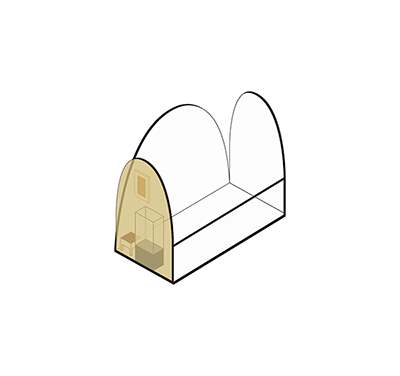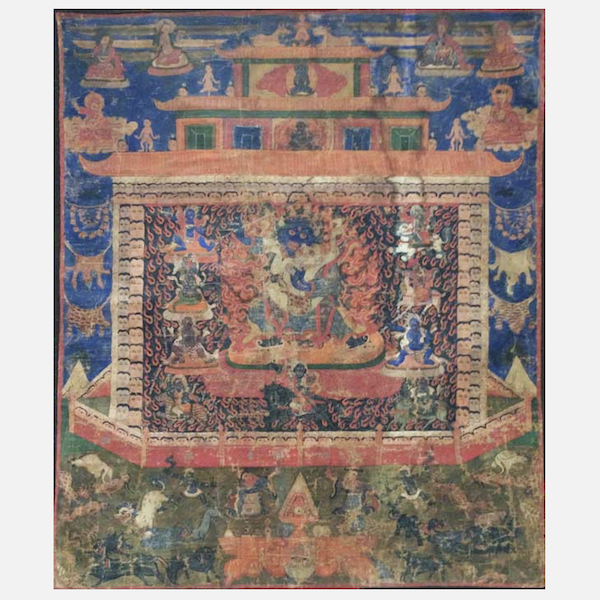
ABP 069
Code: ABP 069
Country: Tibet
Style:
Date: 1500 - 1600
Dimensions in cm WxHxD: 64.5 x 111
Materials: Pigment on cotton
Standing in union upon a lotus seat and a sun disc amidst a mass of blazing wisdom fire at the centre of his palace, he is surrounded by nine attendants. The main level of the three storeys building is made of three types of human heads: fresh, rotting and dried. This type of construction is called thod mkhar in Tibetan literally meaning “Fortress made of skulls”. On the middle flour stands a brown wrathful deity and on top of it is the primordial Buddha Samantabhadra.
The construction is surrounded with terrifying charnel ground ornaments: flayed skins, wild animals devouring corpses, offerings, two tantric practitioners and their black-skinned attendants. An altar filled with the ritual artefacts, musical instruments and wrathful offerings stands in the front of the composition.
Often translated in English as “Eunuch” – one of the possible meanings of the Tibetan term ma ning – it appears here illogical considering the fact that the main deity is represented in union with his consort.
Very popular among the Nyingma practitioners, Maning Nagpo represents the third class or lineage of wisdom protectors along the male (pho rgyud) and female (mo rgyud). In a Nyingma liturgy for protectors, Dudjom Rinpoché describes him as: “gnyid med ye shes ma ning” or “Ma ning of the non-dual primordial wisdom”. This status implies a non-dual nature better rendered by “hermaphrodite” than “eunuch”, a being that belongs neither to a category nor the other.
Rather strangely, Maning Nagpo is absent from the chapter devoted to “the group of the mGon po” in René de Nebesky Wojkovitz’s work. The only mention of Maning is a description of the protector without his consort and presented as an attendant of the goddess “lHa mo ekajati”. This short account presents him accompanied with five emanations.
(From Wikipedia, the free encyclopedia)
Mahakala is a Dharmapala("protector of dharma") in Vajrayana Buddhism (Tibetan Buddhism and Japanese Shingon Buddhism).
In Japanese Buddhism, Mahakala (Jpn: Daikoku), belongs to the fourth hierarchy of deities (tenbu).
Name
Mahakala is a Sanskrit bahuvrihi of maha ("great") and kala ("black"). The Tibetan name is Gonpo Phyag (Wylie: mGon po phyag ).
Description
Mahakala is relied upon in all schools of Tibetan Buddhism. However, he is depicted in a number of variations, each with distinctly different qualities and aspects. He is also regarded as the emanation of different beings in different cases, namely Avalokiteshvara (Tib: Chenrezig) or Chakrasamvara (Tib: Korlo Demchog, Wylie: ’khor-lo bde-mchog).
Mahakala is typically black in color. Just as all colors are absorbed and dissolved into black, all names and forms are said to melt into those of Mahakala, symbolizing his all-embracing, comprehensive nature. Black can also represent the total absence of color, and again in this case it signifies the nature of Mahakala as ultimate or absolute reality. This principle is known in Sanskrit as "nirguna", beyond all quality and form, and it is typified by both interpretations.
Mahakala is almost always depicted with a crown of five skulls, which representing the transmutation of the five kleshas(negative afflictions) into the five wisdoms.
The most notable variation in Mahakala's manifestations and depictions is in the number of arms, but other details can vary as well. For instance, in some cases there are Mahakalas in white, with multiple heads, without genitals, standing on varying numbers of various things, holding various implements, with alternative adornments, and so on.
Manifestations
Six-Armed Mahakala
The Six-Armed Mahakala (Skt: Shad-bhuja Mahakala, Wylie: mGon po phyag drug pa) is favored by the Gelug order of Tibetan Buddhism, and in this manifestation is considered to be a fierce and powerful emanation of Avalokitesvara, the bodhisattva of compassion.
He is adorned with the following symbolic attributes:
1. The Six Arms signify the successful completion of the six perfections (shad-paramita), which are practiced and brought to perfection by bodhisattvas during the course of their training.
2. various implements in each hand.
There is also a White Six-Armed Mahakala (Skt: Shad-bhuja Sita Mahakala; Tib. Wylie: mGon po yid bzhin nor bu) popular among Mongolian Gelugpas. In this case, he is a "wealth deity", specifically supporting the comfort and economic well-being of tantric practitioners. As such, his iconography differs in form and symbolism, with his skull bowl containing various jewels rather than the typical mortal remains of his victims, and a crown of jewels instead of skulls. The following description is found in his sadhana: "His body is white. His face is wrathful, and he has three eyes. He has six arms. His main right hand holds a wish-fulfilling jewel (cintamani) mounted on a jewel-tipped handle, in front of his chest."
Four-Armed Mahakalas
Various Four-armed Mahakalas (Skt. Chatur-bhuja Mahakala, Tib. Wylie: mGon po phyag bzhi pa) are the primary protectors of the Karma Kagyu and Drikung Kagyu schools of Tibetan Buddhism. A four-armed Mahakala is also found in the Nyingma school, although the primary protector of the Great Perfection (Skt: Mahasandhi, Tib. Dzogchen) teachings which are the pinnacle of the Nyingma system is Ekajati.
The four arms of this manifestation of Mahakala perform one of the following four positive karmas or actions, which are said to be his specific boon to his worshippers:
* Pacify sickness, hindrances, and troubles.
* Increase life, good qualities and wisdom.
* Attract whatever Dharma practitioners need and bring people to the Dharma.
* Destroy confusion, doubt, and ignorance.
Two-Armed Mahakalas
The two-armed Mahakala called Bernakchen is a protector of the Karma Kagyu school. It is often thought to be the primary protector, but it is actually the main protector of the Karmapas specifically.
Panjaranatha Mahakala, 'Lord of Charms" or "Lord of the Pavilion", an emanation of Manjushri is a protector of the Sakya order.
Bazin, Nathalie, 2014. L’art bouddhique du Tibet. Paris: Nouvelles éditions Scala, Lyon, Musée national des arts asiatiques Guimet.
Beer, Robert , 1999. The Encyclopedia of Tibetan Symbols and Motives. Boston: Shambala.
Béguin, Gilles, 1990. Art ésotérique de l’Himâlaya, la donation Lionel Fournier. Paris: Réunion des musées nationaux.
Boyer, Marion, 2010. La peinture bouddhiste tibétaine, découvrir, comprendre et conserver les thangkas. Paris: Eyrolles.
Essen, Gerd-Wolfgang and Thingo, Tsering Tashi, 1990. Die Götter des Himalaya - Buddhistische Kunst Tibets. München: Prestel-Verlag.
Karmay, Samten G., 1998. “The Man and the Ox: a Ritual for Offering the glud” in The Arrow and the Spindle, Studies in History, Myths, Rituals and Beliefs in Tibet. Kathmandu: Mandala Book Point.
Kreijger, Hugo E. , 2001. Tibetan Painting: The Jucker Collection. London: Serindia Publ..

